Strategic Management: Alternative Approaches Report - MGT302
VerifiedAdded on 2022/08/24
|10
|3431
|19
Report
AI Summary
This report provides an in-depth analysis of three key strategic management approaches: sustainability, stakeholder, and dynamic capabilities. It begins with an introduction to strategic management, emphasizing its importance in adapting to a changing business environment. The report then delves into each approach, discussing their history, suggested benefits, and limitations. The sustainability approach focuses on long-term social welfare, the stakeholder approach prioritizes fulfilling stakeholder needs, and the dynamic capabilities approach emphasizes adapting to changing environments. Each approach is illustrated with examples of organizations that have implemented them, such as Adidas (sustainability), Marks & Spencer (stakeholder), and the gap between economics based.
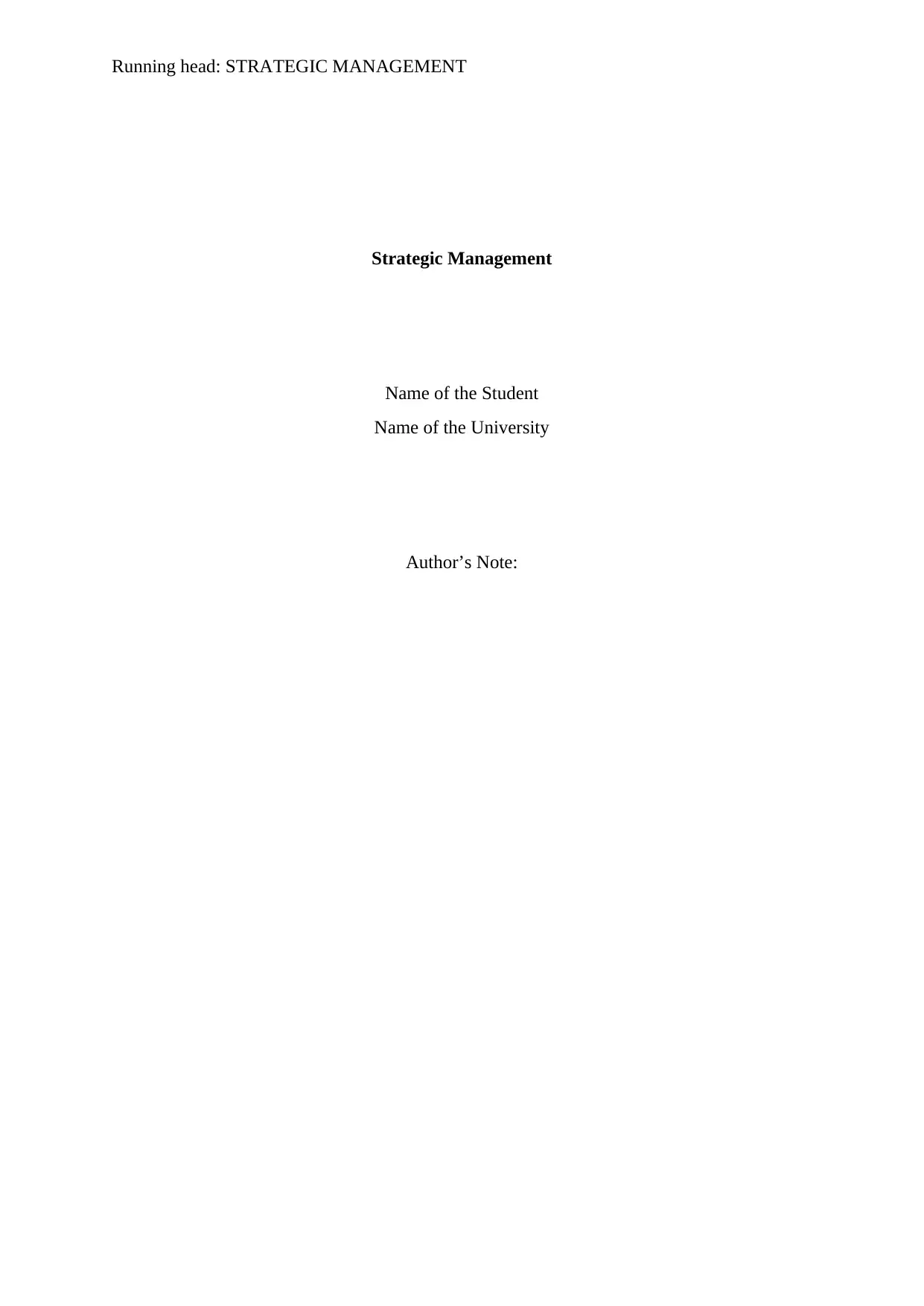
Running head: STRATEGIC MANAGEMENT
Strategic Management
Name of the Student
Name of the University
Author’s Note:
Strategic Management
Name of the Student
Name of the University
Author’s Note:
Paraphrase This Document
Need a fresh take? Get an instant paraphrase of this document with our AI Paraphraser
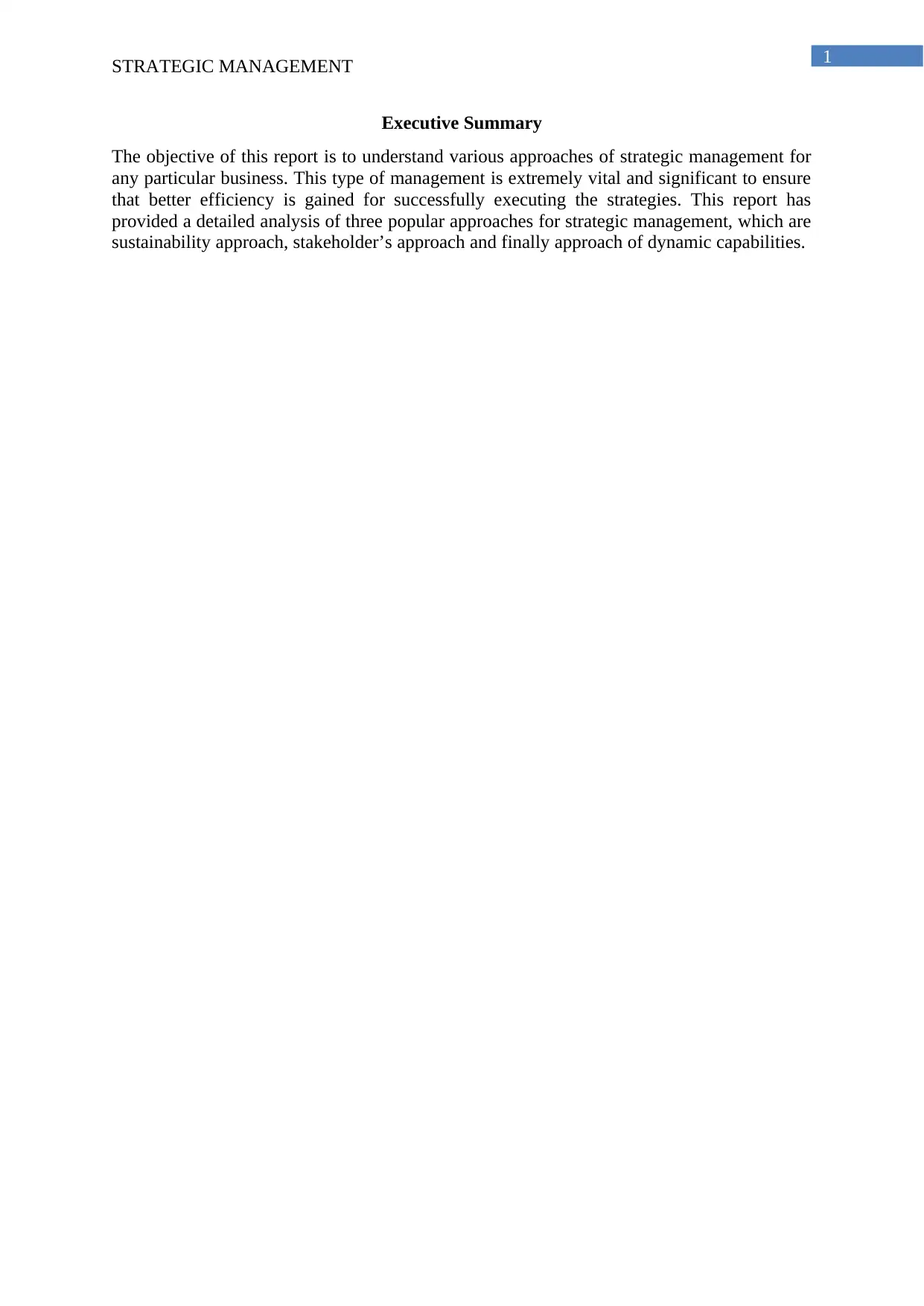
1
STRATEGIC MANAGEMENT
Executive Summary
The objective of this report is to understand various approaches of strategic management for
any particular business. This type of management is extremely vital and significant to ensure
that better efficiency is gained for successfully executing the strategies. This report has
provided a detailed analysis of three popular approaches for strategic management, which are
sustainability approach, stakeholder’s approach and finally approach of dynamic capabilities.
STRATEGIC MANAGEMENT
Executive Summary
The objective of this report is to understand various approaches of strategic management for
any particular business. This type of management is extremely vital and significant to ensure
that better efficiency is gained for successfully executing the strategies. This report has
provided a detailed analysis of three popular approaches for strategic management, which are
sustainability approach, stakeholder’s approach and finally approach of dynamic capabilities.

2
STRATEGIC MANAGEMENT
Table of Contents
1. Introduction............................................................................................................................3
2. Three Suitable Approaches for Strategic Management.........................................................3
3. Conclusion..............................................................................................................................7
Reference List............................................................................................................................8
Appendix....................................................................................................................................9
STRATEGIC MANAGEMENT
Table of Contents
1. Introduction............................................................................................................................3
2. Three Suitable Approaches for Strategic Management.........................................................3
3. Conclusion..............................................................................................................................7
Reference List............................................................................................................................8
Appendix....................................................................................................................................9
⊘ This is a preview!⊘
Do you want full access?
Subscribe today to unlock all pages.

Trusted by 1+ million students worldwide
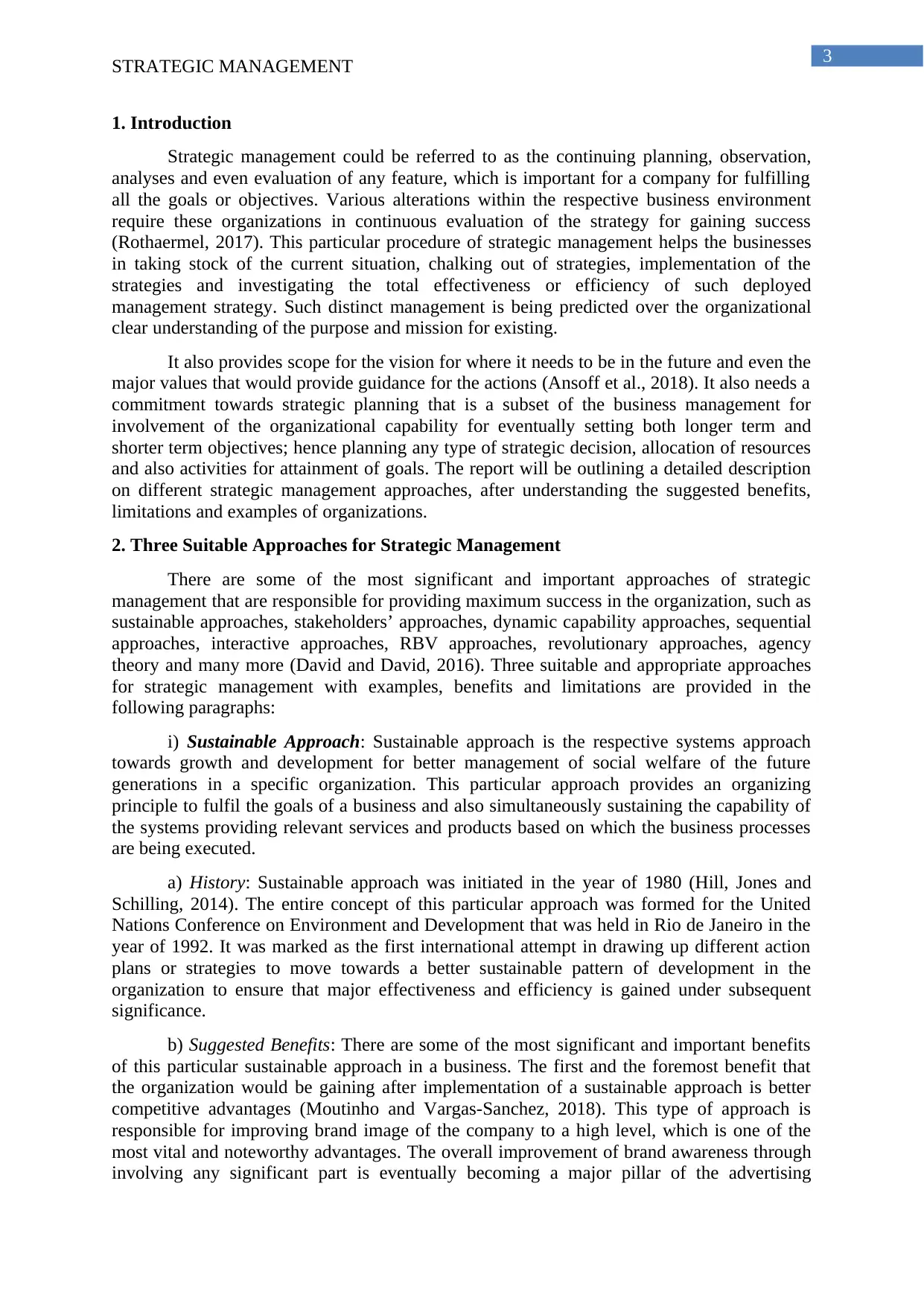
3
STRATEGIC MANAGEMENT
1. Introduction
Strategic management could be referred to as the continuing planning, observation,
analyses and even evaluation of any feature, which is important for a company for fulfilling
all the goals or objectives. Various alterations within the respective business environment
require these organizations in continuous evaluation of the strategy for gaining success
(Rothaermel, 2017). This particular procedure of strategic management helps the businesses
in taking stock of the current situation, chalking out of strategies, implementation of the
strategies and investigating the total effectiveness or efficiency of such deployed
management strategy. Such distinct management is being predicted over the organizational
clear understanding of the purpose and mission for existing.
It also provides scope for the vision for where it needs to be in the future and even the
major values that would provide guidance for the actions (Ansoff et al., 2018). It also needs a
commitment towards strategic planning that is a subset of the business management for
involvement of the organizational capability for eventually setting both longer term and
shorter term objectives; hence planning any type of strategic decision, allocation of resources
and also activities for attainment of goals. The report will be outlining a detailed description
on different strategic management approaches, after understanding the suggested benefits,
limitations and examples of organizations.
2. Three Suitable Approaches for Strategic Management
There are some of the most significant and important approaches of strategic
management that are responsible for providing maximum success in the organization, such as
sustainable approaches, stakeholders’ approaches, dynamic capability approaches, sequential
approaches, interactive approaches, RBV approaches, revolutionary approaches, agency
theory and many more (David and David, 2016). Three suitable and appropriate approaches
for strategic management with examples, benefits and limitations are provided in the
following paragraphs:
i) Sustainable Approach: Sustainable approach is the respective systems approach
towards growth and development for better management of social welfare of the future
generations in a specific organization. This particular approach provides an organizing
principle to fulfil the goals of a business and also simultaneously sustaining the capability of
the systems providing relevant services and products based on which the business processes
are being executed.
a) History: Sustainable approach was initiated in the year of 1980 (Hill, Jones and
Schilling, 2014). The entire concept of this particular approach was formed for the United
Nations Conference on Environment and Development that was held in Rio de Janeiro in the
year of 1992. It was marked as the first international attempt in drawing up different action
plans or strategies to move towards a better sustainable pattern of development in the
organization to ensure that major effectiveness and efficiency is gained under subsequent
significance.
b) Suggested Benefits: There are some of the most significant and important benefits
of this particular sustainable approach in a business. The first and the foremost benefit that
the organization would be gaining after implementation of a sustainable approach is better
competitive advantages (Moutinho and Vargas-Sanchez, 2018). This type of approach is
responsible for improving brand image of the company to a high level, which is one of the
most vital and noteworthy advantages. The overall improvement of brand awareness through
involving any significant part is eventually becoming a major pillar of the advertising
STRATEGIC MANAGEMENT
1. Introduction
Strategic management could be referred to as the continuing planning, observation,
analyses and even evaluation of any feature, which is important for a company for fulfilling
all the goals or objectives. Various alterations within the respective business environment
require these organizations in continuous evaluation of the strategy for gaining success
(Rothaermel, 2017). This particular procedure of strategic management helps the businesses
in taking stock of the current situation, chalking out of strategies, implementation of the
strategies and investigating the total effectiveness or efficiency of such deployed
management strategy. Such distinct management is being predicted over the organizational
clear understanding of the purpose and mission for existing.
It also provides scope for the vision for where it needs to be in the future and even the
major values that would provide guidance for the actions (Ansoff et al., 2018). It also needs a
commitment towards strategic planning that is a subset of the business management for
involvement of the organizational capability for eventually setting both longer term and
shorter term objectives; hence planning any type of strategic decision, allocation of resources
and also activities for attainment of goals. The report will be outlining a detailed description
on different strategic management approaches, after understanding the suggested benefits,
limitations and examples of organizations.
2. Three Suitable Approaches for Strategic Management
There are some of the most significant and important approaches of strategic
management that are responsible for providing maximum success in the organization, such as
sustainable approaches, stakeholders’ approaches, dynamic capability approaches, sequential
approaches, interactive approaches, RBV approaches, revolutionary approaches, agency
theory and many more (David and David, 2016). Three suitable and appropriate approaches
for strategic management with examples, benefits and limitations are provided in the
following paragraphs:
i) Sustainable Approach: Sustainable approach is the respective systems approach
towards growth and development for better management of social welfare of the future
generations in a specific organization. This particular approach provides an organizing
principle to fulfil the goals of a business and also simultaneously sustaining the capability of
the systems providing relevant services and products based on which the business processes
are being executed.
a) History: Sustainable approach was initiated in the year of 1980 (Hill, Jones and
Schilling, 2014). The entire concept of this particular approach was formed for the United
Nations Conference on Environment and Development that was held in Rio de Janeiro in the
year of 1992. It was marked as the first international attempt in drawing up different action
plans or strategies to move towards a better sustainable pattern of development in the
organization to ensure that major effectiveness and efficiency is gained under subsequent
significance.
b) Suggested Benefits: There are some of the most significant and important benefits
of this particular sustainable approach in a business. The first and the foremost benefit that
the organization would be gaining after implementation of a sustainable approach is better
competitive advantages (Moutinho and Vargas-Sanchez, 2018). This type of approach is
responsible for improving brand image of the company to a high level, which is one of the
most vital and noteworthy advantages. The overall improvement of brand awareness through
involving any significant part is eventually becoming a major pillar of the advertising
Paraphrase This Document
Need a fresh take? Get an instant paraphrase of this document with our AI Paraphraser
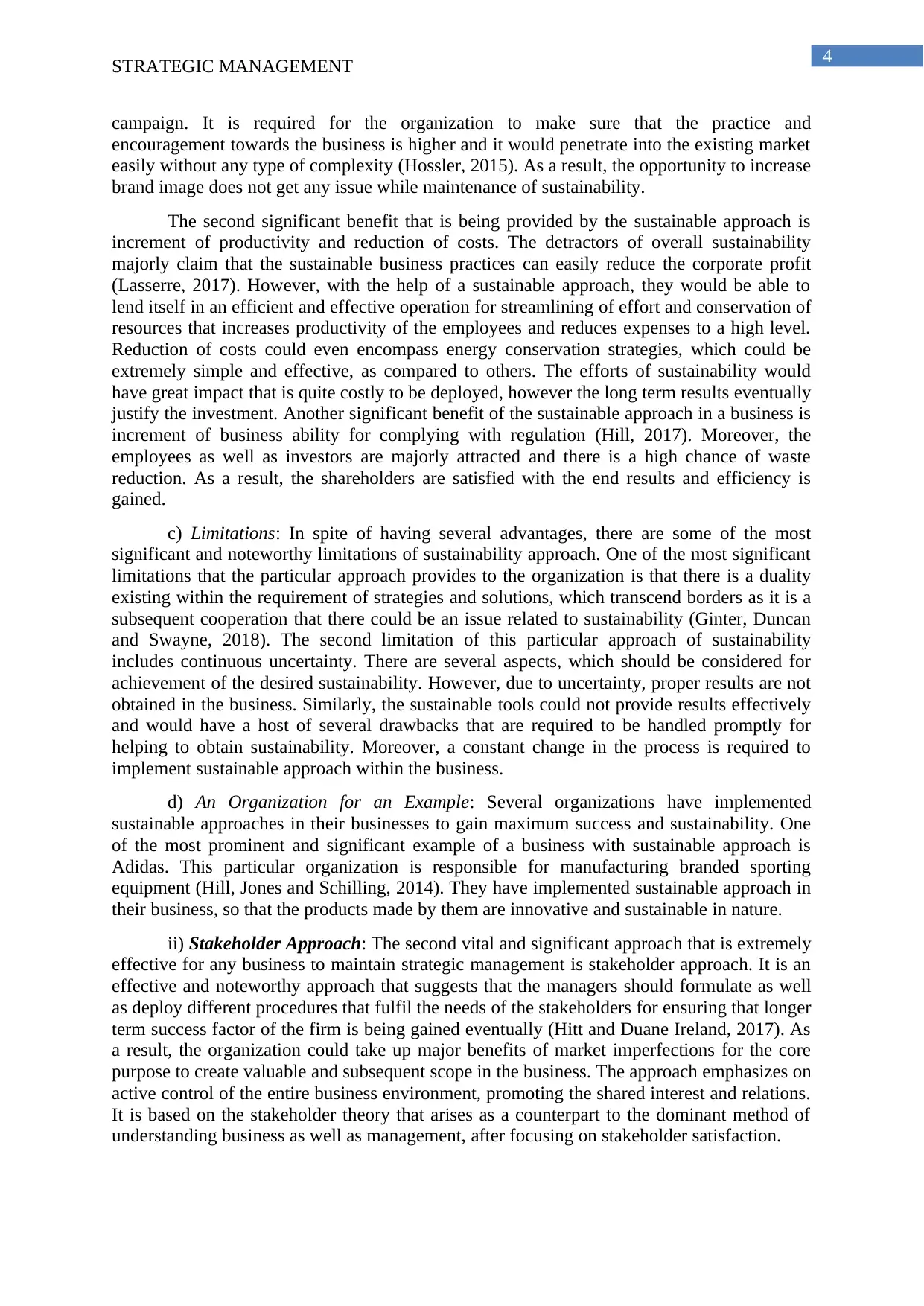
4
STRATEGIC MANAGEMENT
campaign. It is required for the organization to make sure that the practice and
encouragement towards the business is higher and it would penetrate into the existing market
easily without any type of complexity (Hossler, 2015). As a result, the opportunity to increase
brand image does not get any issue while maintenance of sustainability.
The second significant benefit that is being provided by the sustainable approach is
increment of productivity and reduction of costs. The detractors of overall sustainability
majorly claim that the sustainable business practices can easily reduce the corporate profit
(Lasserre, 2017). However, with the help of a sustainable approach, they would be able to
lend itself in an efficient and effective operation for streamlining of effort and conservation of
resources that increases productivity of the employees and reduces expenses to a high level.
Reduction of costs could even encompass energy conservation strategies, which could be
extremely simple and effective, as compared to others. The efforts of sustainability would
have great impact that is quite costly to be deployed, however the long term results eventually
justify the investment. Another significant benefit of the sustainable approach in a business is
increment of business ability for complying with regulation (Hill, 2017). Moreover, the
employees as well as investors are majorly attracted and there is a high chance of waste
reduction. As a result, the shareholders are satisfied with the end results and efficiency is
gained.
c) Limitations: In spite of having several advantages, there are some of the most
significant and noteworthy limitations of sustainability approach. One of the most significant
limitations that the particular approach provides to the organization is that there is a duality
existing within the requirement of strategies and solutions, which transcend borders as it is a
subsequent cooperation that there could be an issue related to sustainability (Ginter, Duncan
and Swayne, 2018). The second limitation of this particular approach of sustainability
includes continuous uncertainty. There are several aspects, which should be considered for
achievement of the desired sustainability. However, due to uncertainty, proper results are not
obtained in the business. Similarly, the sustainable tools could not provide results effectively
and would have a host of several drawbacks that are required to be handled promptly for
helping to obtain sustainability. Moreover, a constant change in the process is required to
implement sustainable approach within the business.
d) An Organization for an Example: Several organizations have implemented
sustainable approaches in their businesses to gain maximum success and sustainability. One
of the most prominent and significant example of a business with sustainable approach is
Adidas. This particular organization is responsible for manufacturing branded sporting
equipment (Hill, Jones and Schilling, 2014). They have implemented sustainable approach in
their business, so that the products made by them are innovative and sustainable in nature.
ii) Stakeholder Approach: The second vital and significant approach that is extremely
effective for any business to maintain strategic management is stakeholder approach. It is an
effective and noteworthy approach that suggests that the managers should formulate as well
as deploy different procedures that fulfil the needs of the stakeholders for ensuring that longer
term success factor of the firm is being gained eventually (Hitt and Duane Ireland, 2017). As
a result, the organization could take up major benefits of market imperfections for the core
purpose to create valuable and subsequent scope in the business. The approach emphasizes on
active control of the entire business environment, promoting the shared interest and relations.
It is based on the stakeholder theory that arises as a counterpart to the dominant method of
understanding business as well as management, after focusing on stakeholder satisfaction.
STRATEGIC MANAGEMENT
campaign. It is required for the organization to make sure that the practice and
encouragement towards the business is higher and it would penetrate into the existing market
easily without any type of complexity (Hossler, 2015). As a result, the opportunity to increase
brand image does not get any issue while maintenance of sustainability.
The second significant benefit that is being provided by the sustainable approach is
increment of productivity and reduction of costs. The detractors of overall sustainability
majorly claim that the sustainable business practices can easily reduce the corporate profit
(Lasserre, 2017). However, with the help of a sustainable approach, they would be able to
lend itself in an efficient and effective operation for streamlining of effort and conservation of
resources that increases productivity of the employees and reduces expenses to a high level.
Reduction of costs could even encompass energy conservation strategies, which could be
extremely simple and effective, as compared to others. The efforts of sustainability would
have great impact that is quite costly to be deployed, however the long term results eventually
justify the investment. Another significant benefit of the sustainable approach in a business is
increment of business ability for complying with regulation (Hill, 2017). Moreover, the
employees as well as investors are majorly attracted and there is a high chance of waste
reduction. As a result, the shareholders are satisfied with the end results and efficiency is
gained.
c) Limitations: In spite of having several advantages, there are some of the most
significant and noteworthy limitations of sustainability approach. One of the most significant
limitations that the particular approach provides to the organization is that there is a duality
existing within the requirement of strategies and solutions, which transcend borders as it is a
subsequent cooperation that there could be an issue related to sustainability (Ginter, Duncan
and Swayne, 2018). The second limitation of this particular approach of sustainability
includes continuous uncertainty. There are several aspects, which should be considered for
achievement of the desired sustainability. However, due to uncertainty, proper results are not
obtained in the business. Similarly, the sustainable tools could not provide results effectively
and would have a host of several drawbacks that are required to be handled promptly for
helping to obtain sustainability. Moreover, a constant change in the process is required to
implement sustainable approach within the business.
d) An Organization for an Example: Several organizations have implemented
sustainable approaches in their businesses to gain maximum success and sustainability. One
of the most prominent and significant example of a business with sustainable approach is
Adidas. This particular organization is responsible for manufacturing branded sporting
equipment (Hill, Jones and Schilling, 2014). They have implemented sustainable approach in
their business, so that the products made by them are innovative and sustainable in nature.
ii) Stakeholder Approach: The second vital and significant approach that is extremely
effective for any business to maintain strategic management is stakeholder approach. It is an
effective and noteworthy approach that suggests that the managers should formulate as well
as deploy different procedures that fulfil the needs of the stakeholders for ensuring that longer
term success factor of the firm is being gained eventually (Hitt and Duane Ireland, 2017). As
a result, the organization could take up major benefits of market imperfections for the core
purpose to create valuable and subsequent scope in the business. The approach emphasizes on
active control of the entire business environment, promoting the shared interest and relations.
It is based on the stakeholder theory that arises as a counterpart to the dominant method of
understanding business as well as management, after focusing on stakeholder satisfaction.
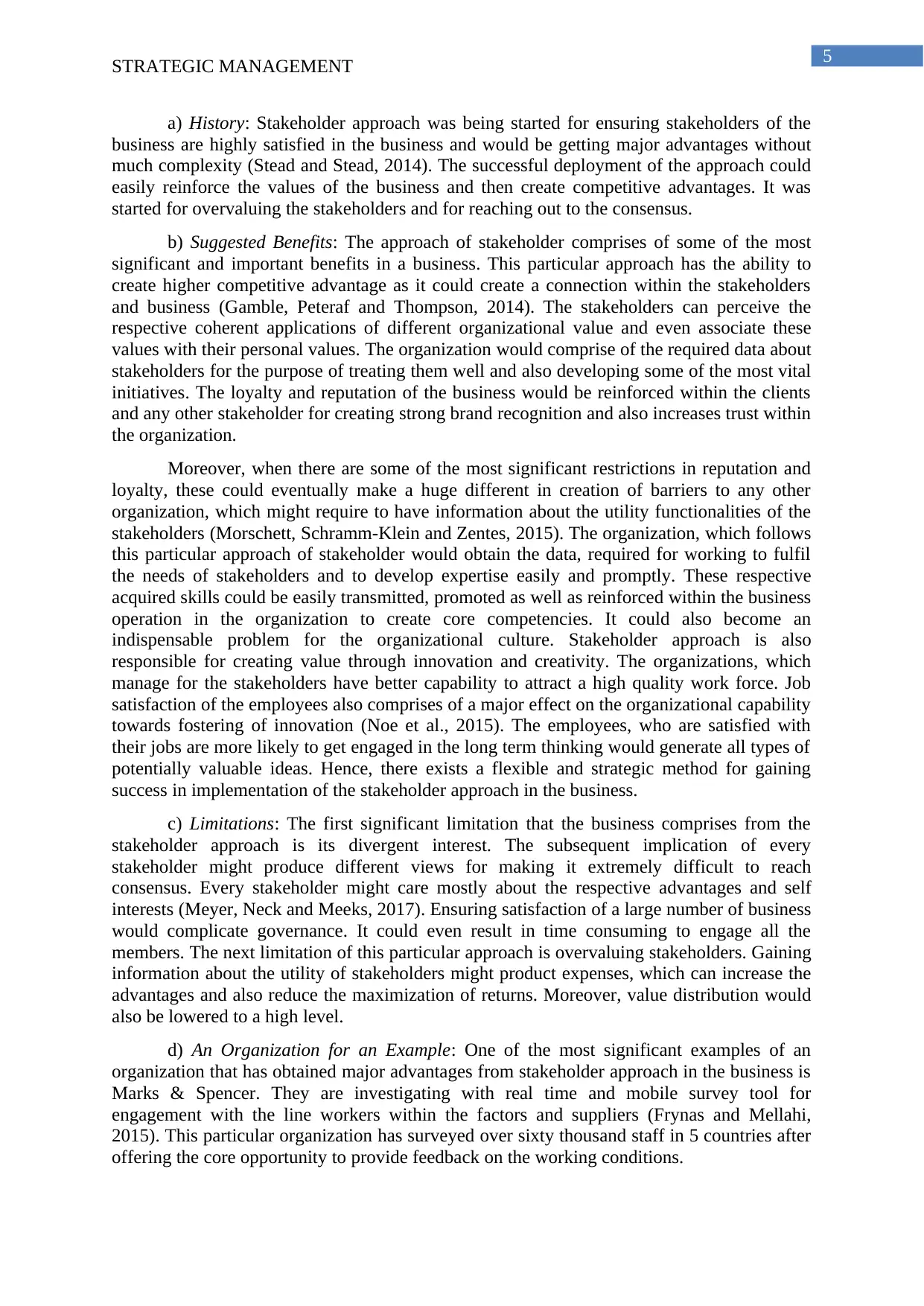
5
STRATEGIC MANAGEMENT
a) History: Stakeholder approach was being started for ensuring stakeholders of the
business are highly satisfied in the business and would be getting major advantages without
much complexity (Stead and Stead, 2014). The successful deployment of the approach could
easily reinforce the values of the business and then create competitive advantages. It was
started for overvaluing the stakeholders and for reaching out to the consensus.
b) Suggested Benefits: The approach of stakeholder comprises of some of the most
significant and important benefits in a business. This particular approach has the ability to
create higher competitive advantage as it could create a connection within the stakeholders
and business (Gamble, Peteraf and Thompson, 2014). The stakeholders can perceive the
respective coherent applications of different organizational value and even associate these
values with their personal values. The organization would comprise of the required data about
stakeholders for the purpose of treating them well and also developing some of the most vital
initiatives. The loyalty and reputation of the business would be reinforced within the clients
and any other stakeholder for creating strong brand recognition and also increases trust within
the organization.
Moreover, when there are some of the most significant restrictions in reputation and
loyalty, these could eventually make a huge different in creation of barriers to any other
organization, which might require to have information about the utility functionalities of the
stakeholders (Morschett, Schramm-Klein and Zentes, 2015). The organization, which follows
this particular approach of stakeholder would obtain the data, required for working to fulfil
the needs of stakeholders and to develop expertise easily and promptly. These respective
acquired skills could be easily transmitted, promoted as well as reinforced within the business
operation in the organization to create core competencies. It could also become an
indispensable problem for the organizational culture. Stakeholder approach is also
responsible for creating value through innovation and creativity. The organizations, which
manage for the stakeholders have better capability to attract a high quality work force. Job
satisfaction of the employees also comprises of a major effect on the organizational capability
towards fostering of innovation (Noe et al., 2015). The employees, who are satisfied with
their jobs are more likely to get engaged in the long term thinking would generate all types of
potentially valuable ideas. Hence, there exists a flexible and strategic method for gaining
success in implementation of the stakeholder approach in the business.
c) Limitations: The first significant limitation that the business comprises from the
stakeholder approach is its divergent interest. The subsequent implication of every
stakeholder might produce different views for making it extremely difficult to reach
consensus. Every stakeholder might care mostly about the respective advantages and self
interests (Meyer, Neck and Meeks, 2017). Ensuring satisfaction of a large number of business
would complicate governance. It could even result in time consuming to engage all the
members. The next limitation of this particular approach is overvaluing stakeholders. Gaining
information about the utility of stakeholders might product expenses, which can increase the
advantages and also reduce the maximization of returns. Moreover, value distribution would
also be lowered to a high level.
d) An Organization for an Example: One of the most significant examples of an
organization that has obtained major advantages from stakeholder approach in the business is
Marks & Spencer. They are investigating with real time and mobile survey tool for
engagement with the line workers within the factors and suppliers (Frynas and Mellahi,
2015). This particular organization has surveyed over sixty thousand staff in 5 countries after
offering the core opportunity to provide feedback on the working conditions.
STRATEGIC MANAGEMENT
a) History: Stakeholder approach was being started for ensuring stakeholders of the
business are highly satisfied in the business and would be getting major advantages without
much complexity (Stead and Stead, 2014). The successful deployment of the approach could
easily reinforce the values of the business and then create competitive advantages. It was
started for overvaluing the stakeholders and for reaching out to the consensus.
b) Suggested Benefits: The approach of stakeholder comprises of some of the most
significant and important benefits in a business. This particular approach has the ability to
create higher competitive advantage as it could create a connection within the stakeholders
and business (Gamble, Peteraf and Thompson, 2014). The stakeholders can perceive the
respective coherent applications of different organizational value and even associate these
values with their personal values. The organization would comprise of the required data about
stakeholders for the purpose of treating them well and also developing some of the most vital
initiatives. The loyalty and reputation of the business would be reinforced within the clients
and any other stakeholder for creating strong brand recognition and also increases trust within
the organization.
Moreover, when there are some of the most significant restrictions in reputation and
loyalty, these could eventually make a huge different in creation of barriers to any other
organization, which might require to have information about the utility functionalities of the
stakeholders (Morschett, Schramm-Klein and Zentes, 2015). The organization, which follows
this particular approach of stakeholder would obtain the data, required for working to fulfil
the needs of stakeholders and to develop expertise easily and promptly. These respective
acquired skills could be easily transmitted, promoted as well as reinforced within the business
operation in the organization to create core competencies. It could also become an
indispensable problem for the organizational culture. Stakeholder approach is also
responsible for creating value through innovation and creativity. The organizations, which
manage for the stakeholders have better capability to attract a high quality work force. Job
satisfaction of the employees also comprises of a major effect on the organizational capability
towards fostering of innovation (Noe et al., 2015). The employees, who are satisfied with
their jobs are more likely to get engaged in the long term thinking would generate all types of
potentially valuable ideas. Hence, there exists a flexible and strategic method for gaining
success in implementation of the stakeholder approach in the business.
c) Limitations: The first significant limitation that the business comprises from the
stakeholder approach is its divergent interest. The subsequent implication of every
stakeholder might produce different views for making it extremely difficult to reach
consensus. Every stakeholder might care mostly about the respective advantages and self
interests (Meyer, Neck and Meeks, 2017). Ensuring satisfaction of a large number of business
would complicate governance. It could even result in time consuming to engage all the
members. The next limitation of this particular approach is overvaluing stakeholders. Gaining
information about the utility of stakeholders might product expenses, which can increase the
advantages and also reduce the maximization of returns. Moreover, value distribution would
also be lowered to a high level.
d) An Organization for an Example: One of the most significant examples of an
organization that has obtained major advantages from stakeholder approach in the business is
Marks & Spencer. They are investigating with real time and mobile survey tool for
engagement with the line workers within the factors and suppliers (Frynas and Mellahi,
2015). This particular organization has surveyed over sixty thousand staff in 5 countries after
offering the core opportunity to provide feedback on the working conditions.
⊘ This is a preview!⊘
Do you want full access?
Subscribe today to unlock all pages.

Trusted by 1+ million students worldwide
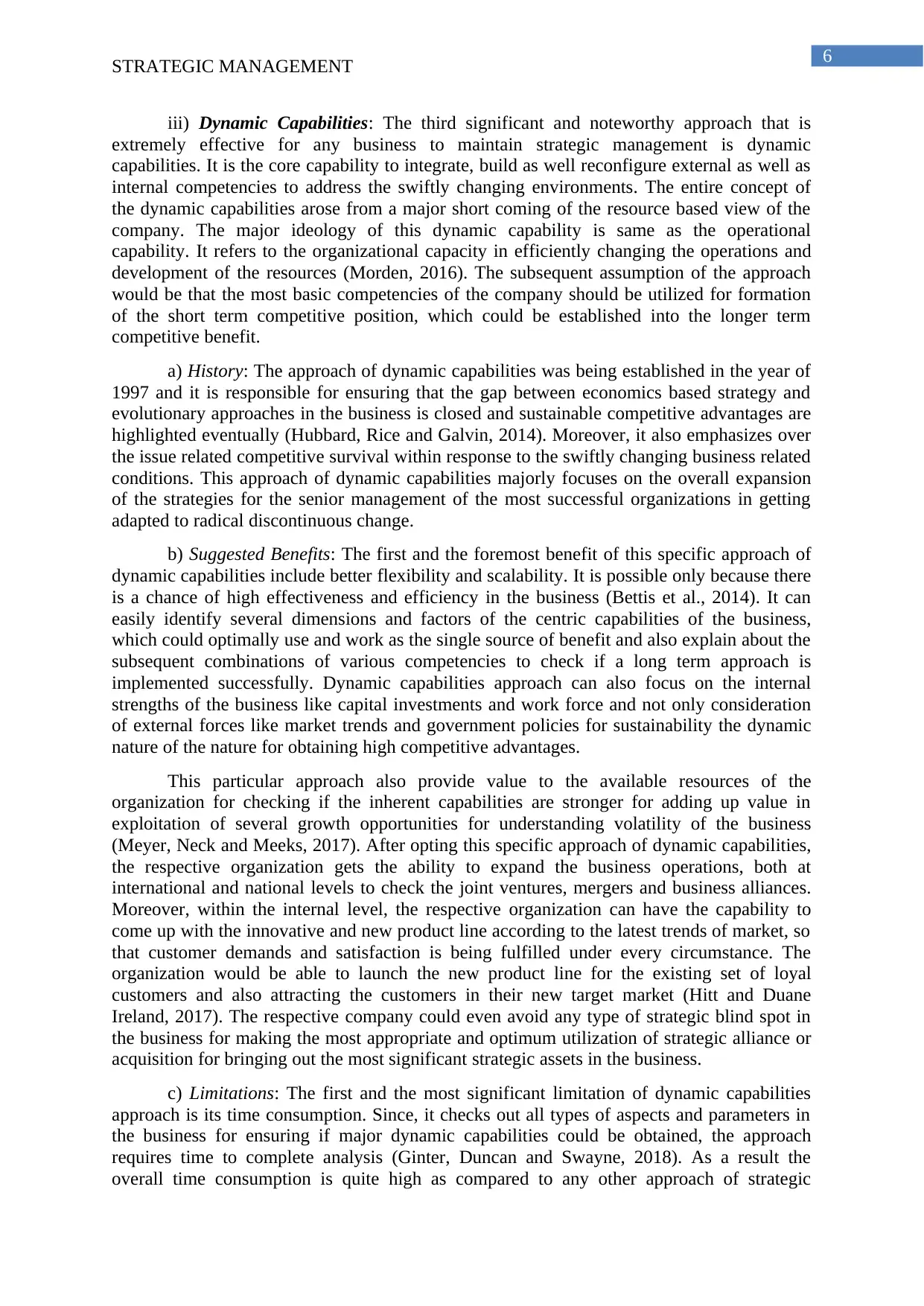
6
STRATEGIC MANAGEMENT
iii) Dynamic Capabilities: The third significant and noteworthy approach that is
extremely effective for any business to maintain strategic management is dynamic
capabilities. It is the core capability to integrate, build as well reconfigure external as well as
internal competencies to address the swiftly changing environments. The entire concept of
the dynamic capabilities arose from a major short coming of the resource based view of the
company. The major ideology of this dynamic capability is same as the operational
capability. It refers to the organizational capacity in efficiently changing the operations and
development of the resources (Morden, 2016). The subsequent assumption of the approach
would be that the most basic competencies of the company should be utilized for formation
of the short term competitive position, which could be established into the longer term
competitive benefit.
a) History: The approach of dynamic capabilities was being established in the year of
1997 and it is responsible for ensuring that the gap between economics based strategy and
evolutionary approaches in the business is closed and sustainable competitive advantages are
highlighted eventually (Hubbard, Rice and Galvin, 2014). Moreover, it also emphasizes over
the issue related competitive survival within response to the swiftly changing business related
conditions. This approach of dynamic capabilities majorly focuses on the overall expansion
of the strategies for the senior management of the most successful organizations in getting
adapted to radical discontinuous change.
b) Suggested Benefits: The first and the foremost benefit of this specific approach of
dynamic capabilities include better flexibility and scalability. It is possible only because there
is a chance of high effectiveness and efficiency in the business (Bettis et al., 2014). It can
easily identify several dimensions and factors of the centric capabilities of the business,
which could optimally use and work as the single source of benefit and also explain about the
subsequent combinations of various competencies to check if a long term approach is
implemented successfully. Dynamic capabilities approach can also focus on the internal
strengths of the business like capital investments and work force and not only consideration
of external forces like market trends and government policies for sustainability the dynamic
nature of the nature for obtaining high competitive advantages.
This particular approach also provide value to the available resources of the
organization for checking if the inherent capabilities are stronger for adding up value in
exploitation of several growth opportunities for understanding volatility of the business
(Meyer, Neck and Meeks, 2017). After opting this specific approach of dynamic capabilities,
the respective organization gets the ability to expand the business operations, both at
international and national levels to check the joint ventures, mergers and business alliances.
Moreover, within the internal level, the respective organization can have the capability to
come up with the innovative and new product line according to the latest trends of market, so
that customer demands and satisfaction is being fulfilled under every circumstance. The
organization would be able to launch the new product line for the existing set of loyal
customers and also attracting the customers in their new target market (Hitt and Duane
Ireland, 2017). The respective company could even avoid any type of strategic blind spot in
the business for making the most appropriate and optimum utilization of strategic alliance or
acquisition for bringing out the most significant strategic assets in the business.
c) Limitations: The first and the most significant limitation of dynamic capabilities
approach is its time consumption. Since, it checks out all types of aspects and parameters in
the business for ensuring if major dynamic capabilities could be obtained, the approach
requires time to complete analysis (Ginter, Duncan and Swayne, 2018). As a result the
overall time consumption is quite high as compared to any other approach of strategic
STRATEGIC MANAGEMENT
iii) Dynamic Capabilities: The third significant and noteworthy approach that is
extremely effective for any business to maintain strategic management is dynamic
capabilities. It is the core capability to integrate, build as well reconfigure external as well as
internal competencies to address the swiftly changing environments. The entire concept of
the dynamic capabilities arose from a major short coming of the resource based view of the
company. The major ideology of this dynamic capability is same as the operational
capability. It refers to the organizational capacity in efficiently changing the operations and
development of the resources (Morden, 2016). The subsequent assumption of the approach
would be that the most basic competencies of the company should be utilized for formation
of the short term competitive position, which could be established into the longer term
competitive benefit.
a) History: The approach of dynamic capabilities was being established in the year of
1997 and it is responsible for ensuring that the gap between economics based strategy and
evolutionary approaches in the business is closed and sustainable competitive advantages are
highlighted eventually (Hubbard, Rice and Galvin, 2014). Moreover, it also emphasizes over
the issue related competitive survival within response to the swiftly changing business related
conditions. This approach of dynamic capabilities majorly focuses on the overall expansion
of the strategies for the senior management of the most successful organizations in getting
adapted to radical discontinuous change.
b) Suggested Benefits: The first and the foremost benefit of this specific approach of
dynamic capabilities include better flexibility and scalability. It is possible only because there
is a chance of high effectiveness and efficiency in the business (Bettis et al., 2014). It can
easily identify several dimensions and factors of the centric capabilities of the business,
which could optimally use and work as the single source of benefit and also explain about the
subsequent combinations of various competencies to check if a long term approach is
implemented successfully. Dynamic capabilities approach can also focus on the internal
strengths of the business like capital investments and work force and not only consideration
of external forces like market trends and government policies for sustainability the dynamic
nature of the nature for obtaining high competitive advantages.
This particular approach also provide value to the available resources of the
organization for checking if the inherent capabilities are stronger for adding up value in
exploitation of several growth opportunities for understanding volatility of the business
(Meyer, Neck and Meeks, 2017). After opting this specific approach of dynamic capabilities,
the respective organization gets the ability to expand the business operations, both at
international and national levels to check the joint ventures, mergers and business alliances.
Moreover, within the internal level, the respective organization can have the capability to
come up with the innovative and new product line according to the latest trends of market, so
that customer demands and satisfaction is being fulfilled under every circumstance. The
organization would be able to launch the new product line for the existing set of loyal
customers and also attracting the customers in their new target market (Hitt and Duane
Ireland, 2017). The respective company could even avoid any type of strategic blind spot in
the business for making the most appropriate and optimum utilization of strategic alliance or
acquisition for bringing out the most significant strategic assets in the business.
c) Limitations: The first and the most significant limitation of dynamic capabilities
approach is its time consumption. Since, it checks out all types of aspects and parameters in
the business for ensuring if major dynamic capabilities could be obtained, the approach
requires time to complete analysis (Ginter, Duncan and Swayne, 2018). As a result the
overall time consumption is quite high as compared to any other approach of strategic
Paraphrase This Document
Need a fresh take? Get an instant paraphrase of this document with our AI Paraphraser
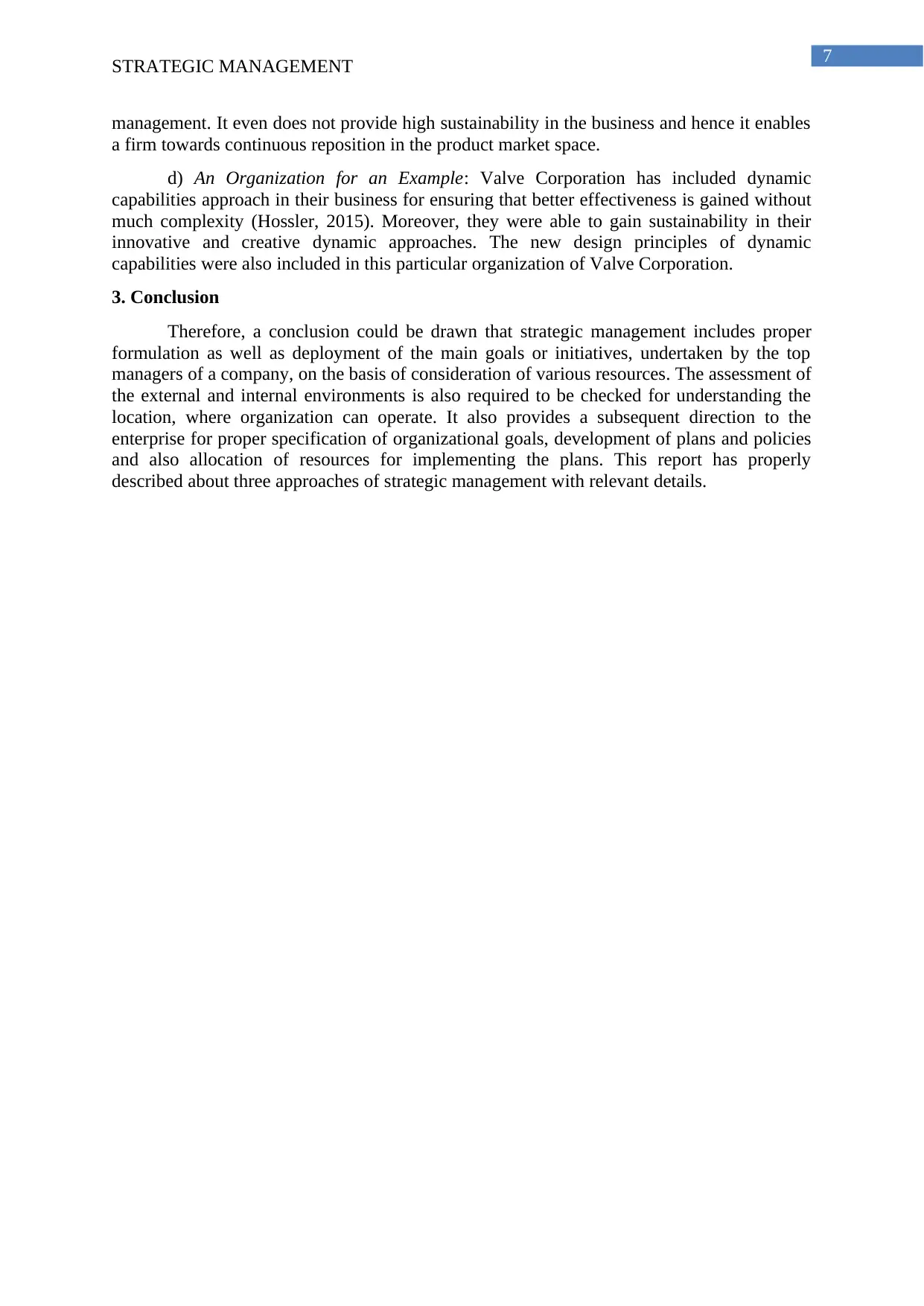
7
STRATEGIC MANAGEMENT
management. It even does not provide high sustainability in the business and hence it enables
a firm towards continuous reposition in the product market space.
d) An Organization for an Example: Valve Corporation has included dynamic
capabilities approach in their business for ensuring that better effectiveness is gained without
much complexity (Hossler, 2015). Moreover, they were able to gain sustainability in their
innovative and creative dynamic approaches. The new design principles of dynamic
capabilities were also included in this particular organization of Valve Corporation.
3. Conclusion
Therefore, a conclusion could be drawn that strategic management includes proper
formulation as well as deployment of the main goals or initiatives, undertaken by the top
managers of a company, on the basis of consideration of various resources. The assessment of
the external and internal environments is also required to be checked for understanding the
location, where organization can operate. It also provides a subsequent direction to the
enterprise for proper specification of organizational goals, development of plans and policies
and also allocation of resources for implementing the plans. This report has properly
described about three approaches of strategic management with relevant details.
STRATEGIC MANAGEMENT
management. It even does not provide high sustainability in the business and hence it enables
a firm towards continuous reposition in the product market space.
d) An Organization for an Example: Valve Corporation has included dynamic
capabilities approach in their business for ensuring that better effectiveness is gained without
much complexity (Hossler, 2015). Moreover, they were able to gain sustainability in their
innovative and creative dynamic approaches. The new design principles of dynamic
capabilities were also included in this particular organization of Valve Corporation.
3. Conclusion
Therefore, a conclusion could be drawn that strategic management includes proper
formulation as well as deployment of the main goals or initiatives, undertaken by the top
managers of a company, on the basis of consideration of various resources. The assessment of
the external and internal environments is also required to be checked for understanding the
location, where organization can operate. It also provides a subsequent direction to the
enterprise for proper specification of organizational goals, development of plans and policies
and also allocation of resources for implementing the plans. This report has properly
described about three approaches of strategic management with relevant details.
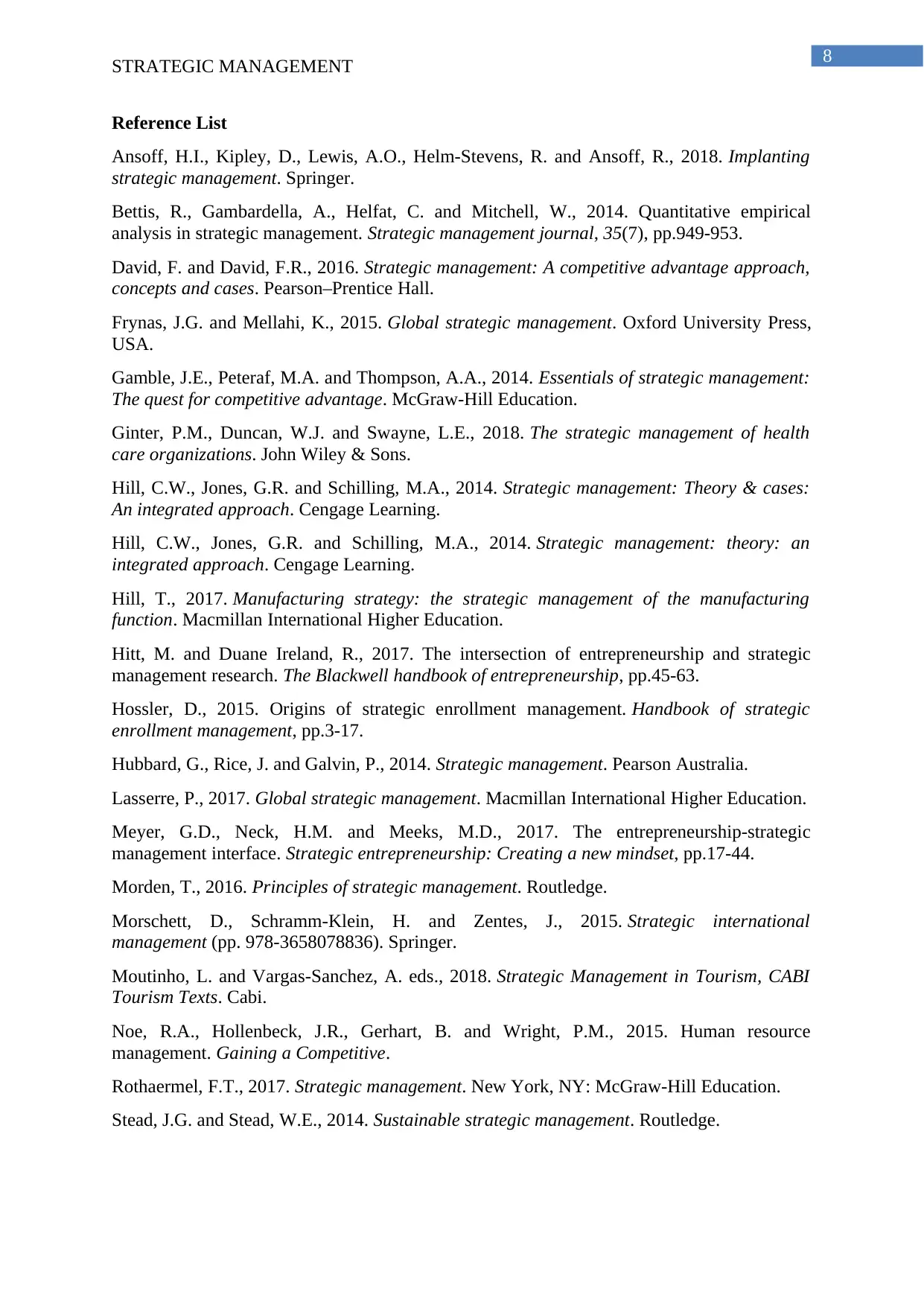
8
STRATEGIC MANAGEMENT
Reference List
Ansoff, H.I., Kipley, D., Lewis, A.O., Helm-Stevens, R. and Ansoff, R., 2018. Implanting
strategic management. Springer.
Bettis, R., Gambardella, A., Helfat, C. and Mitchell, W., 2014. Quantitative empirical
analysis in strategic management. Strategic management journal, 35(7), pp.949-953.
David, F. and David, F.R., 2016. Strategic management: A competitive advantage approach,
concepts and cases. Pearson–Prentice Hall.
Frynas, J.G. and Mellahi, K., 2015. Global strategic management. Oxford University Press,
USA.
Gamble, J.E., Peteraf, M.A. and Thompson, A.A., 2014. Essentials of strategic management:
The quest for competitive advantage. McGraw-Hill Education.
Ginter, P.M., Duncan, W.J. and Swayne, L.E., 2018. The strategic management of health
care organizations. John Wiley & Sons.
Hill, C.W., Jones, G.R. and Schilling, M.A., 2014. Strategic management: Theory & cases:
An integrated approach. Cengage Learning.
Hill, C.W., Jones, G.R. and Schilling, M.A., 2014. Strategic management: theory: an
integrated approach. Cengage Learning.
Hill, T., 2017. Manufacturing strategy: the strategic management of the manufacturing
function. Macmillan International Higher Education.
Hitt, M. and Duane Ireland, R., 2017. The intersection of entrepreneurship and strategic
management research. The Blackwell handbook of entrepreneurship, pp.45-63.
Hossler, D., 2015. Origins of strategic enrollment management. Handbook of strategic
enrollment management, pp.3-17.
Hubbard, G., Rice, J. and Galvin, P., 2014. Strategic management. Pearson Australia.
Lasserre, P., 2017. Global strategic management. Macmillan International Higher Education.
Meyer, G.D., Neck, H.M. and Meeks, M.D., 2017. The entrepreneurship‐strategic
management interface. Strategic entrepreneurship: Creating a new mindset, pp.17-44.
Morden, T., 2016. Principles of strategic management. Routledge.
Morschett, D., Schramm-Klein, H. and Zentes, J., 2015. Strategic international
management (pp. 978-3658078836). Springer.
Moutinho, L. and Vargas-Sanchez, A. eds., 2018. Strategic Management in Tourism, CABI
Tourism Texts. Cabi.
Noe, R.A., Hollenbeck, J.R., Gerhart, B. and Wright, P.M., 2015. Human resource
management. Gaining a Competitive.
Rothaermel, F.T., 2017. Strategic management. New York, NY: McGraw-Hill Education.
Stead, J.G. and Stead, W.E., 2014. Sustainable strategic management. Routledge.
STRATEGIC MANAGEMENT
Reference List
Ansoff, H.I., Kipley, D., Lewis, A.O., Helm-Stevens, R. and Ansoff, R., 2018. Implanting
strategic management. Springer.
Bettis, R., Gambardella, A., Helfat, C. and Mitchell, W., 2014. Quantitative empirical
analysis in strategic management. Strategic management journal, 35(7), pp.949-953.
David, F. and David, F.R., 2016. Strategic management: A competitive advantage approach,
concepts and cases. Pearson–Prentice Hall.
Frynas, J.G. and Mellahi, K., 2015. Global strategic management. Oxford University Press,
USA.
Gamble, J.E., Peteraf, M.A. and Thompson, A.A., 2014. Essentials of strategic management:
The quest for competitive advantage. McGraw-Hill Education.
Ginter, P.M., Duncan, W.J. and Swayne, L.E., 2018. The strategic management of health
care organizations. John Wiley & Sons.
Hill, C.W., Jones, G.R. and Schilling, M.A., 2014. Strategic management: Theory & cases:
An integrated approach. Cengage Learning.
Hill, C.W., Jones, G.R. and Schilling, M.A., 2014. Strategic management: theory: an
integrated approach. Cengage Learning.
Hill, T., 2017. Manufacturing strategy: the strategic management of the manufacturing
function. Macmillan International Higher Education.
Hitt, M. and Duane Ireland, R., 2017. The intersection of entrepreneurship and strategic
management research. The Blackwell handbook of entrepreneurship, pp.45-63.
Hossler, D., 2015. Origins of strategic enrollment management. Handbook of strategic
enrollment management, pp.3-17.
Hubbard, G., Rice, J. and Galvin, P., 2014. Strategic management. Pearson Australia.
Lasserre, P., 2017. Global strategic management. Macmillan International Higher Education.
Meyer, G.D., Neck, H.M. and Meeks, M.D., 2017. The entrepreneurship‐strategic
management interface. Strategic entrepreneurship: Creating a new mindset, pp.17-44.
Morden, T., 2016. Principles of strategic management. Routledge.
Morschett, D., Schramm-Klein, H. and Zentes, J., 2015. Strategic international
management (pp. 978-3658078836). Springer.
Moutinho, L. and Vargas-Sanchez, A. eds., 2018. Strategic Management in Tourism, CABI
Tourism Texts. Cabi.
Noe, R.A., Hollenbeck, J.R., Gerhart, B. and Wright, P.M., 2015. Human resource
management. Gaining a Competitive.
Rothaermel, F.T., 2017. Strategic management. New York, NY: McGraw-Hill Education.
Stead, J.G. and Stead, W.E., 2014. Sustainable strategic management. Routledge.
⊘ This is a preview!⊘
Do you want full access?
Subscribe today to unlock all pages.

Trusted by 1+ million students worldwide
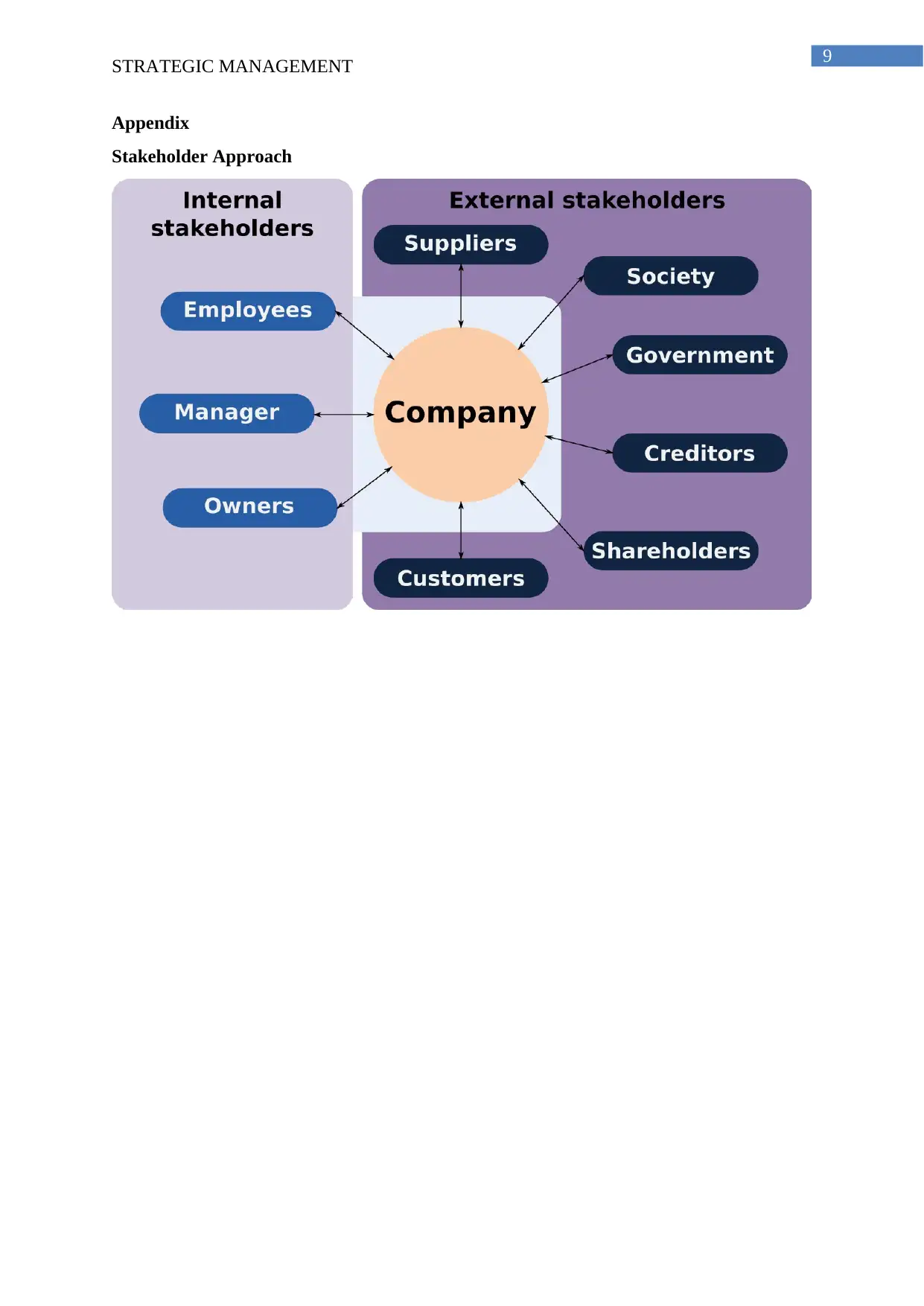
9
STRATEGIC MANAGEMENT
Appendix
Stakeholder Approach
STRATEGIC MANAGEMENT
Appendix
Stakeholder Approach
1 out of 10
Related Documents
Your All-in-One AI-Powered Toolkit for Academic Success.
+13062052269
info@desklib.com
Available 24*7 on WhatsApp / Email
![[object Object]](/_next/static/media/star-bottom.7253800d.svg)
Unlock your academic potential
Copyright © 2020–2025 A2Z Services. All Rights Reserved. Developed and managed by ZUCOL.




